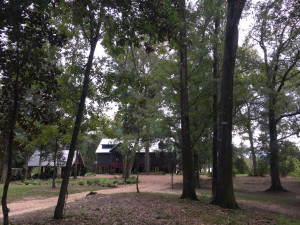 By Alexandra Ford | GFC Forester & Stewardship Specialist
By Alexandra Ford | GFC Forester & Stewardship Specialist
Georgia is well known for its timberland and forest industry. Unfortunately, for a lot of landowners within the state, their property may be overlooked and undermanaged because it measures 20 acres or fewer.
No matter how much forestland you have, every bit of it matters to you. Georgia’s Conservation Woodland Program was created to help forest landowners actively manage their property for their specific purposes. From timber management and wildlife habitat to recreation, growing your own vegetables, and creating biochar, any number of objectives can be met. The program features multiple in-depth documents, internet links, and the capability to create your custom management plan. With this program and website, everything is at hand to help you manage your forestland.
Here’s how it works. Begin by pinpointing your property’s location using the map link we’ve created and learn about the soil types and plant hardiness zone found on your property. This information will help match future tree, shrub, or vegetable selections. The map also displays potential threatened or endangered species that might be found on your property, along with contact information for your local Georgia Forestry Commission, Natural Resource and Conservation Service, Farm Service Agency, and Department of Natural Resource offices. Lastly, the map provides the locations of any public access, such as Wildlife Management Areas and state parks.
Exploring the website further, the first management objective cited is Timber Management, which includes tree planting, timber harvesting, prescribed burning, and smoke management. These sections provide detailed information on how to properly plant your desired trees, whether they be for timber production, aesthetics, wildlife habitat, or producing your own food. Timber harvesting covers types of timber harvests, recommendations on how to conduct them, and making your trees more desirable by joining with neighbors on the harvest. Lastly, the prescribed burning and smoke management section introduces you to the perks and necessity of prescribed fire, how to properly burn, and information on educational and outreach opportunities about prescribed fire.
Because urban areas throughout Georgia are always expanding and your property may be inside city limits, resources and a direct link to GFC’s Urban and Community Forest Department are found on this webpage. There you’ll see tools such as “Ask the Arborist,” tree care manuals, community outreach opportunities, and information about the Wildland Urban Interface, Tree City USA, and a host of other programs.
To help with challenges you might not even realize exist on your property, we have included sections on Forest Health and Invasive Species Identification and Control. Here you’ll find additional documents and links about which forest health and invasive species issues occur throughout Georgia, how to identify them, and the proper methods of control. It is critical these forest health issues be addressed to maintain the vigor of our forested lands.
Water and water quality are crucial to both humans and wildlife. The Conservation Woodland Program will help you better manage any Riparian Habitat. As a landowner, it’s important to know what type of tree and vegetation you have growing on your land. Some trees might be valuable for making furniture, raking pine straw or producing acorns for wildlife. Using links provided within the Tree Identification section, you can identify exactly what is growing on your land and how best to manage it.
One of the most enjoyable aspects of owning land is the ability to create habitat for wildlife and even yourself! Wildlife Management and Habitat and the Backyard Gardening sections go into detail about how to create, manage and implement practices to provide bedding, nutrients and food, and pollinators for wildlife on your property. If done properly, you will begin to see increased numbers and varieties of animals and insects using your land. And if you can grow food for animals, you can certainly grow food for yourself! We provide documents and external links to assist with recommendations for best-growing selections and soil amendments for optimal outcomes.
With the information provided, you’ll be equipped to create your own management plan for your property. After making selections, adding details, and completing the plan for submission, a Conservation Woodland Program management plan will be generated and reviewed by a GFC forester. Once approved, the plan is returned to you for implementation. As an added bonus, the plan can also be used with an application and other documentation as part of an application for your county Conservation Use Value Assessment (CUVA) Program.
Time to dig in and get to work.
